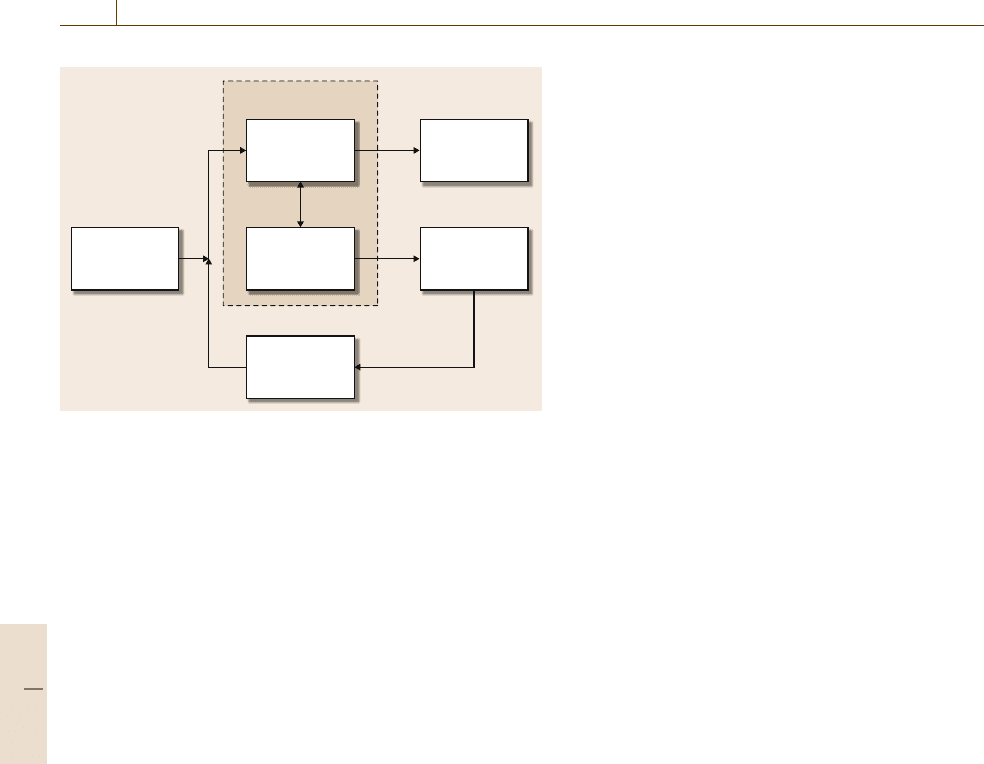Nof S.Y. Springer Handbook of Automation
Подождите немного. Документ загружается.


Product Lifecycle Management and Embedded Information Devices References 765
43.17 I. Inasaki, H.K. Tönshoff: Roles of sensors in man-
ufacturing and application ranges. In: Sensors in
Manufacturing, ed. by H.K. Tönshoff, I. Inasaki
(Wiley, New York 2001)
43.18 CIMdata: Product life cycle management – em-
powering the future of business, Technical Report
(CIMdata, 2002)
43.19 H. Cao, P. Folan, L. Zheng Lu, J. Mascolo,
N. Frantone, J. Browne: Design of an end-of-life
decision support system using product embed-
ded information device technology, ICE Conf. Proc.
(2006)
43.20 PROMISE: PROMISE case studies, public version
available at www.promise-plm.com
Part E 43
“This page left intentionally blank.”

767
Education an
44. Education and Qualification for Control
and Automation
Bozenna Pasik-Duncan, Matthew Verleger
Engineering education has seen an explosion of
interest in recent years, fueled simultaneously by
reports from both industry and academia. Au-
tomatic control education has recently become
a core issue for the international control com-
munity. This has occurred in tandem with the
explosion of interest in engineering education as
a whole. The applications of control are growing
rapidly. There is an increasing interest in con-
trol from researchers from outside of traditionally
control-based fields such as aeronautics, chemical,
mechanical, and electrical engineering. Recently
control and systems theory have had much to
offer to nontraditional control fields such as bi-
ology, biomedicine, finance, actuarial science,
and the social sciences as well as transportation
and telecommunications networks. Complemen-
tary, innovative developments of control and
systems theory have been motivated and inspired
by complex real-world problems. These new de-
velopments present huge challenges in control
education. Meeting these challenges will require
a multifaceted approach by the control community
that includes new approaches to teaching, new
preparations for facing new theoretical control and
systems theory problems, and a critical review of
the status quo. This chapter discusses these new
challenges as well as new approaches to education
and outreach. This chapter starts by presenting an
argument towards the future of controls as the
application of control theory expands into new
and unique disciplines. It provides two case stud-
ies of nontraditional areas where control theory
has been applied: finance and biomedicine. These
two case studies show a high potential for us-
ing powerful fundamental principles and tools of
automatic control in research with an inter-
44.1 The Importance of Automatic Control
in the 21st Century................................ 768
44.2 New Challenges for Education................ 768
44.3 Interdisciplinary Nature
of Stochastic Control ............................. 769
44.4 New Applications of Systems
and Control Theory ............................... 770
44.4.1 Financial Engineering
and Financial Mathematics .......... 770
44.4.2 Biomedical Models: Epilepsy Model 771
44.5 Pedagogical Approaches........................ 772
44.5.1 Coursework ................................ 772
44.5.2 Laboratories as Interactive
Learning Environments ................ 773
44.5.3 Plain Talk on Control
for a Wide Range of the Public...... 774
44.5.4 New Approaches to Cultivating
Students Interest in Math, Science,
Engineering, and Technology
at K-12 Level............................... 774
44.6 Integrating Scholarship, Teaching,
and Learning ....................................... 775
44.7 The Scholarship of Teaching and Learning 775
44.8 Conclusions and Emerging Challenges .... 776
References .................................................. 776
disciplinary nature. The chapter then outlines cur-
rent and future pedagogical approaches being
employed in control education, particularly intro-
ductory courses, around the world. It concludes
with a discussion about the role of scholarship,
teaching, and learning in control education both
now and in the coming years.
Part E 44

768 Part E Automation Management
44.1 The Importance of Automatic Control in the 21st Century
The field of automatic control has a rich history
(Fig.44.1), well presented in a special issue of the Euro-
pean Journal of Control [44.1]. Fleming[44.2] provides
an assessment of its status and needs of control theory
through the 1980s. A broader and more updated report
is provided in [44.3–5].
At its core, control systems engineering involves
a variety of tasks including modeling, identifica-
tion, estimation, simulation, planning, decision making,
optimization, and deterministic and stochastic adap-
tation. While the overarching purpose of any con-
trol system is to assist with the automation of an
event, the successful application of control princi-
ples involves the integration of various tools from
related disciplines such as signal processing, fil-
tering, stochastic analysis, electronics, communica-
tion, software, algorithms, real-time computing, sen-
sors and actuators, as well as application-specific
knowledge.
a) b)
Fig. 44.1a,b The centrifugal governor (a) is widely considered to be the first practical control system, dating back to the
1780s. It was used in the Boulton and Watt steam engine
(b) to regulate the amount of steam allowed into the cylinders
to maintain a constant engine speed
The applications of control automation range from
transportation, telecommunications networks, manufac-
turing, communications, aerospace, process industries
through commercial products reaching as diverse fields
of study as biology [44.6], medicine [44.7–10], and fi-
nance [44.11, 12]. New issues are already appearing in
thenextgenerationoftransportation[44.13]andtelecom-
munications network [44.14] problems, as well as in the
next generation of sensor networks (particularly for ap-
plications such as weather prediction), emergency re-
sponsesystems,andmedicaldevices.Thesearenewchal-
lenges thatcan be solved through the careful application
ofcontrolandsystemstheory.Theimpactofsystemsand
control in the changing world is described in the 2007
ChineseControlConference(CCC)plenarytalkSystems
and Control Impact in a Changing World delivered by
Ted Djaferis, the 2007 President of the Control Systems
Society [44.15]. A more thorough description of control
theory forautomation canbe foundin Chaps. 9–11.
44.2 New Challenges for Education
Marketplace pressures and advances in technology are
driving a need in modern industry for well-trained con-
trol and systems scientists. With its cross-boundary
nature and ever-growing application base, helping
students in all disciplines of science, technology, en-
gineering, and mathematics (STEM) to understand the
power and complexity of control systems is becoming
an even more critical component to the future of tech-
nical education. The need to train all STEM graduates
to be comfortable with control theory generates many
Part E 44.2

Education and Qualification for Control and Automation 44.3 Interdisciplinary Nature of Stochastic Control 769
new challenges in control education which are exten-
sively discussed in [44.16]aswellasinthereportof
the National Science Foundation (NSF) and the Control
Systems Society (CSS) panel on an assessment of the
field [44.4] with its summary given in [44.5].
While the skills necessary for students to become
successful practitioners of their craft are changing, so
too is the background of our students. They are better
prepared to work with modern computing technologies.
The ability to interact with and manipulate a computer
is second nature to today’s connected student [44.18].
Thus the time is ripe for major renovations in con-
trol education as it applies to STEM disciplines. The
first step in the renovation process is to develop cross-
disciplinary examples, demonstrations, and laboratory
exercises that illustrate systems and control across the
entire spectrum of STEM education [44.3–5,19].
The recent National Academy of Engineering
(NAE) report [44.17] identified the attributes and
abilities engineers will need to perform well in
a world driven by rapid technological advancements,
national security needs, aging infrastructure in devel-
oped countries (Table 44.1), environmental challenges
brought about by population growth and diminish-
ing resources, and creation of new disciplines at
the interfaces between engineering and science. The
systems and control community has been actively
involved and engaged in taking a leading role in
shaping the future automatic control engineering cur-
Table 44.1 America’s infrastructure is in dire need of re-
pair: just one of the many problems today’s engineering
students will be facing as they enter the workforce (af-
ter [44.17])
Area Grade Trend
(since 2001)
Roads D
+
↓
Bridges C ↔
Transit C ↓
Aviation D ↔
Schools D ↔
Drinking water D ↓
Watewater D ↓
Dams D ↓
Solid waste C
+
↔
Hazardous waste D
+
↔
Navigable waterways D
+
↓
Energy D
+
↓
America’s infrastructure D
+
GPA
a
total US$ 1.6 trillion
investement
(estimated 5-year
need)
a
grade point average
riculum [44.20], as well as in educating and making
nonengineering communities aware of the benefits and
the power of the systems and control approaches and
tools.
44.3 Interdisciplinary Nature of Stochastic Control
Stochastic adaptive control, whereby the unknown pa-
rameters of a control system are modeled as random
variable or random processes [44.21, 22], can be used
to illustrate the interdisciplinary nature of control.
The general approach to adaptive control (Fig.44.2)
involves a splitting, or separation, of parameter iden-
tification and adaptive control. A system’s behavior
depends on some set of parameters, and the fact that the
values of the parameters are unknown makes the sys-
tem unknown. Some crucial information concerning the
system is not available to the controller, and this infor-
mation can be learned during the system’s performance.
Using that information, the system’s performance can
then be altered to respond. This altered response may in
turn alter the previously unknown parameters. This pro-
cess is repeated in a recursive manner until the system
is shut down.
The described problem is the basic problem of
adaptive control. A stochastic control system can be
described using a stochastic differential equation or
a stochastic partial differential equation. The solution
to the adaptive control problem consists of showing the
strong consistency of the family of estimators of an un-
known parameter and the self-optimality of an adaptive
control that uses the family of estimates. The distur-
bance, or noise, in the system is modeled by a Brownian
motion or more generally by a fractional Brownian
motion (more accurate for recent problems in telecom-
munication, finance or biomedicine) [44.11]. Industrial
operation models are often described by stochastic con-
trolled systems [44.23].
Let us describe a simple adaptive control using
a simple investment model. Consider a model where an
investor has a choice in investing in two assets, a simple
Part E 44.3

770 Part E Automation Management
System
Generic
system
operations
System
output
Parameter
identification
Unknown
control
parameters
Control
parameter
values
Adaptive
control
savings account with a fixed rate of growth (say 3.5%)
or shares of Microsoft stock whose growth is governed
by a Brownian motion with unknown drift and variance.
The investor controls his asset by transferring money
between the stock and the savings account. The goal
is, when the stock is expected to go down, to sell the
Fig. 44.2 The general structure of an adaptive control sys-
tem is one where the critical input control parameters are
outputs of thesystem. Asthe systemoperates overtime, the
parameters are adaptedto control how thesystem functions
in the future
stock and transfer the money to the savings account, but
when the stock is expected to go up to repurchase the
stock before it goes up. The control variable is the to-
tal amount of money transferred from the stock to the
savings account and can be positive (stock has just been
sold) or negative (stock is about to be purchased). The
savings account is governed by a traditional differen-
tial equation and the stock is governed by a stochastic
differentialequation. Thegoal is tofind the optimalcon-
trol so that the expected rate of growth is maximized.
The identification problem is to estimate the unknown
parameters, the drift and variance of the stock’s random-
ness, based on the available observations. The adaptive
control problem is to construct the (certainty equiv-
alence) adaptive control as a function of the current
state and the current estimate of what is expected to
happen.
44.4 New Applications of Systems and Control Theory
The use of systems and control theory has seen an ex-
pansion in recent years into new and emerging fields of
study. This expansion functions as a control system in
itself, with the unknown parameter being the number of
STEM students receiving controls training. The expan-
sion into new disciplines demonstrates the necessity of
controls education for all students in STEM disciplines
by showing that controls theory can be applied in a wide
varietyof unique places for producingsolutions to some
of today’s most complex problems. This demonstration
in turn acts as a driver for the curricular change nec-
essary to result in more STEM students experiencing
control education. As those students graduate, they too
will push the boundaries of what control theory can be
applied to and in turn feed the expansion cycle.
44.4.1 Financial Engineering
and Financial Mathematics
Research in control methods in finance has experi-
enced tremendous progress in recent years. The rapid
progress has necessitated communication and network-
ing between researchers in different disciplines. This
area brings together researchers from mathematical sci-
ences, finance, economics, and engineering. Together,
these people work on advances and future directions
of control methods in portfolio management, stochastic
models of markets and pricing, and hedging of options.
The finance area is highly interdisciplinary. This inter-
disciplinary nature comes from the necessity for a wide
variety of skills and knowledge bases.
As a major impetus for the development of financial
management and economics, the research in financial
engineering has had a major impact on the global econ-
omy. For instance, the Black–Scholes model [44.24]
and its various extensions for pricing of options [44.25]
using stochastic calculus have become a standard prac-
tice nowadays and have led to a revolution in the
financial industry. Incidentally, it also won Scholes and
Merton the Nobel Prize for Economics in 1997 (Black
had unfortunately passed away 2years prior).
Powerful techniques of stochastic analysis and
stochastic control have been brought to almost all as-
pects of finance and resulted in a number of important
advances [44.12]. To name just a few, they include
the studies of valuation of contingent claims in com-
Part E 44.4

Education and Qualification for Control and Automation 44.4 New Applications of Systems and Control Theory 771
plete and incomplete markets, consumption–investment
models with or without constraints, portfolio manage-
ment for institutional investors such as pension funds
and banks, and risk assessment and management using
financial derivatives. At the same time, these appli-
cations require and stimulate many new and exciting
theoretical discoveries within the systems and control
field. Take for instance the study of arbitrage theory,
risk assessment, and portfolio management, which have
collectively led to new developments in martingale the-
ory and stochastic control. Moreover, the development
of financial engineering has created a large demand for
graduates at both Master and Ph.D. levels in industry,
resulting in the introduction of the curriculum in many
universities including Kent State University, Princeton
University, Columbia University, and the University of
California at Berkeley.
Another contribution to the control community from
financial engineering and financial mathematics was the
identification and control of stochastic systems with
noise modeledby a fractional Brownian motion[44.11],
a process that can possess a long-range dependence.
Motivated by the need for this type of process in
telecommunications for models of Ethernet and asyn-
chronous transfer mode (AT M) traffic, a new stochastic
calculus for fractional Brownian motion was developed.
This work in financial engineering and financial math-
ematics has since been successfully used in other fields
such as telecommunications and medicine, in particular
epilepsy analysis of brain waves [44.8,9].
44.4.2 Biomedical Models: Epilepsy Model
Epilepsy is a condition where a person has unprovoked
seizures at two or more separate times in her/his life.
A seizure is an abnormal electrical discharge within
the brain resulting in involuntary changes in move-
ment, sensation, perception, behavior, and/or level of
consciousness. It is estimated that 1% of the popula-
tions of industrialized countries have epilepsy whereas
5–10% of the populations of nonindustrialized coun-
tries have epilepsy. One link has been found between
epilepsy and malnutrition [44.26]. In the USA the num-
ber of epilepsy cases is significantly larger than the
number of cases of people who have Parkinson’s dis-
ease, muscular dystrophy, multiple sclerosis, acquired
immunodeficiency syndrome (AIDS)orAlzheimer’s
disease [44.10]. The organizers of the Third Interna-
tional Workshop on Seizure Prediction in Epilepsy held
in Freiburg, Germany stated in the Welcome to the
Workshop that:
The great interest of participants from all over the
world and the highnumber of originalcontributions
presented ... instills confidence in us that seizure
prediction is a promising field for the years to come.
Epilepsy models, with their complexity, can serve
as an example of interdisciplinary and multidisciplinary
research for which systems and control approaches are
showing considerable promise. The methods pioneered
in the financial mathematics and engineering sector de-
scribed above have been successfully used for detection
and prediction of epileptic seizures. There is published
evidencethat the seizure periodsof brain waves of some
patients have long-range dependencies with nonseizure
periods. Based on some initial work, it seems that the
estimates of the Hurst parameter, which is a charac-
terization of the long-range dependence in fractional
Brownian motion, have a noticeable change prior to and
during a seizure. Some of the algorithms [44.8]used
in identifying the Hurst parameter use stochastic calcu-
lus for fractional Brownian motion that was developed
within the financial engineering and financial mathe-
matics sector. A new application for the Hurst param-
eter, real-time event detection, has recently been identi-
fied [44.9]. The high sensitivity to brain state changes,
ability to operate in real time, and small computational
requirements make Hurst parameter estimation well
suited for implementation into miniature implantable
devices for contingent delivery of antiseizure therapies.
This innovative interdisciplinary research has devel-
oped a new technology for future automated therapeutic
intervention devices to lessen, abort or prevent seizures,
opening the possibility of creating a brain pacemaker.
The goal is, by eliminating the unpredictability of
seizures, to minimize or prevent the disability caused
by epilepsy and hardship it imposes on patients and
their families and communities. It brings a hope to
improve productivity and better quality life for those
afflicted with epilepsy and their families as well as
for care-givers and healthcare providers. The creation
of a seizure warning device will minimize risks of in-
jury, the degrading experience associated with having
seizures in public, and the unpredictable disruption of
normal daily-life activities.
Only collaborative work of engineers, computer
scientists, physicists, physicians, biologists, and math-
ematicians can be successful in solving this type of
complex problem. Based partly on the success thus far,
there is a strong desire for a partnership with control
engineers. The University of Kansas (KU) Stochastic
Adaptive Control Group (SACG) has a long history
Part E 44.4

772 Part E Automation Management
of established collaboration in control education and
research with the KU Medical Center Comprehensive
Epilepsy Center and with Flint Hills Scientific, LLC
(FHS). FHS has one of the largest recorded collections
of long-term patient seizure data and it has used this
data to develop real-time seizure prediction algorithms
which have outperformed other prediction algorithms.
Recently FHS has initiated electrical stimulation con-
trol with a seizure prediction algorithm to prevent the
occurrence of seizures.
44.5 Pedagogical Approaches
The field of control is currently suffering from a fun-
damental design flaw. Because of a push from both
those external to thecontrol community (e.g.,the NAE’s
Engineer of 2020 reports) as well as those internal to
the control community, control has become an essen-
tial component for STEM education. This has resulted
in a flood of “current-state” papers describing methods
and mechanisms that are currently being employed for
teaching control.
The beauty of control as an area of study lies in its
use of many different areas of mathematics: from func-
tional analysis through stochastic processes, stochastic
analysis, stochastic calculus of a fractional Brown-
ian motion, stochastic partial differential equations,
stochastic optimal control to methods of mathematical
statistics, as well as current computational methods in
stochastic differential and partial differential equations.
The curse of control as an area of study lies in its use
of many different areas of mathematics. Because of the
broad spectrum of mathematical tools for approaching
systems and control problems, it is not a subject that al-
lows for practical understanding without some amount
of deep coverage. Likewise, it is a topic that almost de-
mands some hands-on experimentation, which can be
both costly and time consuming. Several approaches are
described for building adequate and appropriate control
coursework into an already packed curriculum.
44.5.1 Coursework
A special pair of issues of the Control Systems Maga-
zine on innovations in undergraduate education [44.28,
29] presents a variety of articles related to undergradu-
ate controlsand systems education broken down intosix
broad categories; Kindergarten-12th grade (K-12) edu-
cation, course and curriculum development, experiment
development, special projects, software and laboratory
development, and lecture material.
Djaferis [44.27]describes a three-pronged approach
to introducing systems and controls in a first-year engi-
neering course. A combination of lectures, simulations,
and a hands-on experiment where student develop a col-
lision avoidance system for a model car (Fig.44.3) are
used to indoctrinate students into how control theory
can be practically applied within the engineering design
process. Because the only prerequisite requirement for
the course is first-semester calculus, it can be offered
during the spring term of the first year, allowing stu-
dents theopportunity to experience controlearly in their
education. Additionally, the author found that the early
introduction to control resulted in a number of students
choosing to take a more advanced course in control as
well as for some to pursue graduate studies of systems
and control.
An example of a new introductory control course
for both engineers and general scientists is described
in [44.30]. The course was taught for over 10 years at
Sweden’s Lund University. The goals for the course
include:
•
Demonstrating the benefits of control and the power
of feedback
•
Describing the role of control in the design process
and the importance of integrated systems
Fig. 44.3 Control laboratory experiment for first-year en-
gineering students (after [44.27])
Part E 44.5

Education and Qualification for Control and Automation 44.5 Pedagogical Approaches 773
•
Introducing the language of systems and control
•
Introducing the basic ideas and concepts of control
•
Explaining fundamental limitations
•
Explaining how to formulate, interpret, and test
specifications
•
Exploring computational tools such as MATLAB
and Simulink [44.32] to compute time and fre-
quency responses
•
Developing practical experience of sketching Bode
diagrams and performing calculations using the as-
sociated plots.
The challenge is to teach students sufficient infor-
mation for understanding the validity of the information
contained in computer plots and to appreciate how to
achieve a satisfactory design that meets the specifica-
tions and necessary criteria. One of the curriculardesign
ideas that fueled the course’s creation was to provide
a course that functioned as both an introduction for
those that elected to continue their control studies as
well as a functionally complete overview for students
who would only take one course on control.
One approach for demonstrating and appreciating
the importance of the dynamics of a system is the use of
the bicycle discussed in detail in [44.33] and proposed
for use in an introductory course. Because of the uni-
versal familiarity of the bicycle, it represents a highly
approachable problem context. It also presents a wide
variety of unique control- and dynamics-related prob-
lems; for example, the fact that when at rest it is an
unstable system but when in motion it exhibits aspects
of stability presents a unique problem situation for stu-
dents to understand. The problem can also be extended
into issues of rear-wheeled steering and other assorted
complexity inducing issues. Finally, the scope of the
problem is such that other non-control-related problems
can be introduced, such as discussions of the elemen-
Fig. 44.4 Autonomous vehicles competing in the DARPA Grand Challenge [44.31]
tal physics of motion and the theoretical aspects of
design.
In response to the National Academy of Engineer-
ing report [44.17,20] in which interdisciplinary system
engineering is cited as an increasingly important as-
pect of modern engineering and of the education of
future engineers projects that integrate elements of
mechanical design, modeling, control system design,
and software implementation were developed at the
University of Illinois at Urbana-Champaign [44.34].
In these projects, control design becomes an inte-
gral part of the larger systems engineering problems
and must be carried out in conjunction with design
and optimization of structural members, choice and
placement of sensors and actuators, electronics, power
considerations, modeling, simulations, identification,
and software developments.
44.5.2 Laboratories as Interactive Learning
Environments
Understanding systems and control demands hands-
on experience. It is nearly impossible to appreciate
the complexities and interactions of a physical system
without witnessing it. Therefore a good control labo-
ratory is important for control education. Advances in
technology have reduced the cost of developing labora-
tories significantly. Numerous courses currently utilize
the Lego Mindstorms kits which include a variety of
sensors and a programmable computer capable of in-
terpreting the sensor’s raw value [44.35–39]. While the
majority of those courses utilize the Lego system as
a vehicle for learning programming concepts or me-
chanical design principles, the sensor capabilities open
the door for use in a systems and control course.
The Intelligent Control Systems Laboratory [44.16]
at Australia’s Griffith University demonstrates con-
Part E 44.5

774 Part E Automation Management
trol through cooperative driverless vehicles. The idea
of intelligent vehicles has brought with it promises
of heightened safety, reliability, and efficiency. In
2004, the Defense Advanced Research Projects Agency
(DARPA) held the first of three DARPA Grand Chal-
lenge prize competitions for driverless vehicles [44.31]
(Fig.44.4). The first year, the best vehicle drove only
7.36miles of the 150mile desert course. In 2006 at the
second challenge, five vehicles completed the course
and all but one of the 23 participating teams achieved
a distance greater than the maximum 7.36miles ob-
tained during the first challenge. In 2007, the third
challenge required participants to navigate a more ur-
ban setting. Six of the 11 participating teams rose to the
challenge and successfully drove through the 60mile
urban course.
Finally, thenumber of interactive tools foreducation
in automatic control is growing rapidly. Many examples
are provided [44.40–43]. A sample plain talk presented
below provides other examples of creative, interesting,
and important modern control engineering education
laboratories.
44.5.3 Plain Talk on Control
for a Wide Range of the Public
The IEEE Control Systems Society Technical Commit-
tee on Control Education has been in the process of
developing a series of short presentations prepared for
a wide range of the public demonstrating the power,
beauty, and excitement of systems and control. These
presentations were given at the workshops for high-
school teachers and students, sponsored by the National
Science Foundation and the Control Systems Society.
They are presented in [44.44,45].
The following is a sample of such talks that were
presented at the 2007 Control and Decision Conference
in New Orleans:
•
T. Djaferis: The Power of Feedback (University of
Massachusetts Amherst)
•
C.G. Cassandras: Joys and Perils of Automation
(Dept. of Manufacturing Engineeringand Center for
Information and Systems Engineering Boston Uni-
versity)
•
R.M. Murray: Control Education and the DARPA
Grand Challenge (Control and Dynamical Systems,
California Institute of Technology)
•
P.R. Kumar: The Next Phase of the Informa-
tion Technology Revolution (University of Illinois,
Urbana-Champaign)
•
C. Tomlin: Controlling Air Traffic (University of
California, Berkeley)
•
M. Spong: Control in Mechatronics and Robotics
(University of Illinois, Urbana-Champaign)
•
W.S. Levine, D. Hristu-Varsakelis: Some Uses for
Computer-AidedControl System Design Software in
Control Education (University of Maryland)
•
I. Osorio: Application of Control Theory to the
Problem of Epilepsy (University of Kansas Medical
Center and Mark Frei Flint Hills Scientific, LLC)
•
D. Duncan, T. Duncan, B. Pasik-Duncan: Random
Walk around Some Problems in Stochastic Systems
and Control (Yale University, University of Kansas)
•
K. Furuta: Understanding Phenomena through Real
Physical Objects–Controlling Pendulum (Tokyo
Denki University, Japan)
•
J. Baillieul: Risk Engineering–Past Successes and
Future Challenges (Intelligent Mechatronics Labo-
ratory, Boston University)
Developing plain talks that can be used by members
of the control community for noncontrol communities
in different settings is very important and has become
a major goal for the control education committees.
It is through these talks that the general population,
particularly children and young adults, can learn to ap-
preciate control and potentially pursue further study of
the topic.
44.5.4 New Approaches to Cultivating
Students Interest in Math, Science,
Engineering, and Technology
at K-12 Level
The IEEE CSS Technical Committee on Control Edu-
cation together with the American Automatic Control
Council (AACC) and the International Federation of
Automatic Control (IFAC) Committees on Control Ed-
ucation has organized a series of workshops for middle-
and high-school students and teachers on The Power,
Beauty, and Excitement of Control at all major control
conferences sponsored by CSS, AACC,andIFAC in
the USA and around the world since 2000 [44.46]. The
model for these workshops was created and developed
at the University of Kansas (KU) 15years ago. The uni-
versity organized semiannual half-day workshops for
fifth- and sixth-graders from local schools to promote
STEM disciplines. They became very successful and
played a major role in establishingan importantpartner-
ship between K-12 and KU [44.47]. Another important
outreach activity for encouraging young people to con-
Part E 44.5
